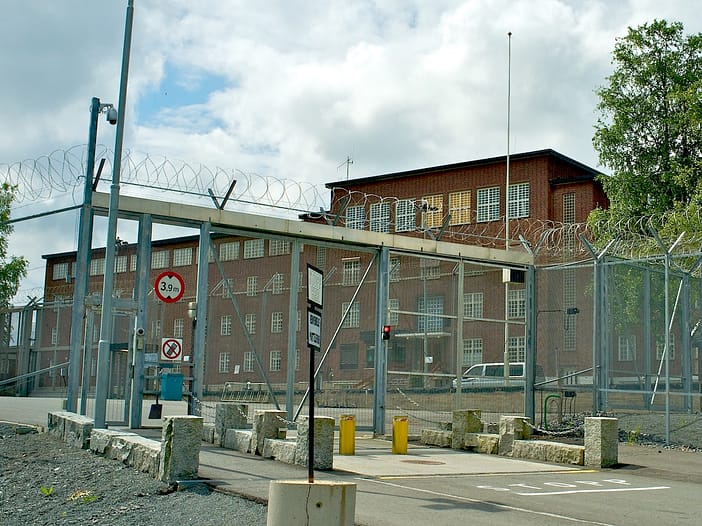
Reentry to Society Is Primary Goal of Norwegian Prisons, Not Punishment
Bastoy Island is just like any other small Norwegian village. It is filled with fishermen along its coasts, who go out in the morning hoping for a good day’s catch. Along with its well-maintained greenery, the island is a beautiful environment and lush space for its inhabitants.
But this island is not typical at all, for its inhabitants are murderers, rapists, thieves, you name it, incarcerated here under their country’s unique, and progressive, penal system. The prisoners work in tandem to focus, not on their past actions which have led them to this irregular form of incarceration, but on their rehabilitation and ability to choose a new path for themselves.
Prisoners Are Treated Like Normal People (as nearly as possible)
Prisoners are counted in the morning and follow a structured working day to hone in on their specific trade in exchange for a stipend. Their work is engaging, personally beneficial, and helpful in finding a skill or hobby that could one day be a livelihood beyond incarceration. Free time is spent swimming on the coasts of the island, fishing, or passing time in the soccer pitch before returning to each prisoners’ respective bungalow.
The island operates under the uncommon philosophy of mutual respect between prisoners and guards and respect for a prisoners’ humanity. The former governor of this prison, Arne Kvernik Nilsen, believes that prisoners will be a product of their environment, suggesting that barbed wires and intimidating guards are not the answer but maybe open layouts and greenery are. “‘And for some people who end up in prison… a lot of these people have lost, or maybe have never been shown any kind of respect to themselves,’” he told the Pulitzer Center.
Personal Responsibility as Tool For Growth
At Bastoy, they work to develop a sense of responsibility in the prisoners and work with them, not against them. Instead of viewing incarceration as a method of punishment, Bastoy and many other Norwegian prisons view incarceration as a vehicle of growth.
History of Norwegian Prison Reform
Norway began its prison reforms in the 1990s after realizing their existing system was ineffective, and furthered their efforts towards modernity in penal practices when they introduced the Reintegration Guarantee.
This strategy works to help those leaving prison to stand independently, obtain housing and employment, and do so without facing social barriers from their community. It allows for ex-inmates to have people looking out for them after their release and make sure that they are going through the release process with ease.
Focus on Resocialization, Education and Finding Employment
Resocialization is much easier through this strategy, as Norway allows its prisoners to be the pioneers in their own release and create their own life, one of self-fulfillment (and self-sufficiency), after incarceration. They work alongside each other throughout their daily responsibilities and jobs, figuring out where their strengths are and what careers they would most enjoy or be best at upon release.
Skills such as collaboration, general education, and specific employment training are provided in a hope to make the transition into a new life easier.
Success of This Model Requires Prisons, Communities and Government to Work Together
Prisons around the word struggle to adopt this method of rehabilitation, partly due to the hostility from members of the community regarding prisoners and also a lack of initiative from the prisons themselves. The Senior Advisor of the Ministry of Justice in Norway, Inger Marie Fridhov, emphasized that the Reintegration Guarantee would only be successful if all parts of society cooperated and worked together.
Frdihov told the Confederation of European Probation, “‘The effort requires a new mindset from the government…now all levels of government and in fact the whole society has to take responsibility for reintegration.”
Bastoy is not only considered the world’s most livable prison, but also has the lowest recidivism (re-offending) rate, and highest post-release employment rate. It demonstrates unequivocally how treating inmates like humans, with dignity and respect, has better results and lower societal costs than the alternatives.
Norwegian prisons are highly focused on providing aid to ex-prisoners and are continuing to make sure that those being released from prison have the right tools to rejoin society, with support from all involved. This philosophy has helped Norway reduce recidivism to the lowest in the world.
According to the 2023 World Population Review, the 2-year reconviction rate in Norway is 20%, a stark contrast to the 2-year reconviction rate of 36% in America, where adopting these perspectives is especially difficult. After 5 years, more than half (55%) of released inmates in the US have been reconvicted and are back in jail.
Contrast With American Prison Model
In America, the unemployment rate of those who were formerly incarcerated is a higher rate than during the Great Depression. The barriers facing prisoners upon release in America are unparalleled due to the stigma surrounding ex-prisoners and the isolation they receive in many aspects of society.
Although effort is being taken towards creating a smoother transition between prison and general society, such training is not always prioritized throughout a prisoners’ sentence resulting in greater difficulty upon release.
Why Prisoner Reintegration Outcomes Show Poorer Results in USA
The reasons for such difficulties in reintegration for prisoners in the U.S. is due to many conflicts, ranging from lack of education to insufficient resources to escape the cycle of recidivism. The prisons and the government do not aid prisoners adequately, pushing for the creation of nonprofits focused on community integration and a strong reliance on these organizations from the prisons and those that are being released from them.
The Brooklyn Community Re-entry Assistance Program (CRAN) works with social workers from Rikers Island, one of the world’s largest detention centers, to aid them in prisoner reintegration and recidivism avoidance through various supportive services such as vocational, housing, and legal aid. They specifically work with prisoners suffering from mental illness and help them to rejoin the community, despite the barriers placed upon ex-prisoners in America.
Homelessness, Lack of Job Opportunities, Poor Social Skills and Mental Illness Are Typical Obstacles Faced By Ex-Inmates Trying To Reintegrate
Margaret Walsh, the program director at the Brooklyn CRAN, has worked with prisoners on reintegration but continues to face obstacles during her work, as she said, “Most of our clients are homeless and that plays a really big part in just their ability to feel stable and overall just, integrate back.”
Transitional Housing
Transitional housing continues to be a deciding factor in a prisoners’ re-entry to society as having a home and a sense of belonging is crucial to their sense of self-confidence and assurance. Formerly incarcerated people have been found to be homeless at a rate much higher than the general public due to insufficient resources and access to housing upon release.
The transition between prison and regular society is constantly strained by this conflict which has proved itself to be one of the most challenging aspects of prisoner reintegration in America.
Social Skills and Mental Illness
Housing is just one facet of a much larger issue with aid upon prison release, as social and community training is just as necessary. After being isolated from the general public for extended amounts of time, prisoners are often forced to relearn what is seen as “basic social skills” and how to interact with others.
The biggest populations in the prison system are those with mental illness, making the need for social reintegration aid even more necessary as mental illness separates these prisoners from the rest of society without the aspect of incarceration even being included. “I don’t think that the prison system is designed for those populations,” said Walsh. “…there’s just not enough support for people who do have mental [illness].”
Social training and courses which emphasize coping with problems such as getting along with others and controlling aggressive behavior during social interaction have been seen to produce benefits for prisoners who participate. These training programs are gradually growing in prominence throughout prisons in America, and are continually proving to improve a prisoners’ ability to rejoin society once released due to the skills they obtained during incarceration.
Norway Teaches Prisoners Normalcy
Norwegian prisons, specifically, begin reintegrating prisoners from the moment they enter the prison itself. Their use of an “open prison” allows for those incarcerated to have a strong sense of normalcy and not lose all connection to regular society, despite being isolated from it. Routines are enforced, and education is highly valued – a trait which allows for a very fluid transition back into normal life upon release.
All Norwegian prisons focus on reintegration to society from the first day an inmate enters, even maximum security jails. It’s a completely different philosophy from any other country, and the astounding results speak for themselves.
Since education is a prominent part of incarceration in Norway, one of the most popular methods for teaching prisoners is bringing in educators from the community and allowing direct interaction. In doing so, ties between prisoners and the general public are better maintained and the sense of hostility that is present in American society is greatly diminished due to these encouraged and fostered relationships.
Vocational and educational training programs also increase a prisoners’ desire for self-improvement, a detail that Norwegian prisons use to their advantage by providing access to libraries and a prison that functions in a similar manner to a community.
What Can Norway Teach America?
There’s More to Incarceration Than Punishment
The American prison system maintains its focus on punishing criminals by separating them from society and disrupting their sense of normalcy, just to push them back into regular life at some point with insufficient aid to ease the transition. Knowing that a large population of incarcerated people in America are mentally ill, there is not enough action taken by the justice system to account for the increased difficulties this population faces upon re-entry.
Learning to Survive and Thrive In Society Is Key
Taking inspiration from prisons in Norway and introducing similar programs and learning opportunities will help prisoners in America experience community support when beginning the reintegration process. Instead of being thrown into a situation that the prisoners are not sufficiently familiar with, they will have experienced that sense of community during incarceration, making it seem as though they are merely shifting from one part of regular society to another.
Education and Vocational Skills Are a Must
The inadequate amount of aid provided by prison social workers upon release will never be enough unless the process is started much earlier. Establishing vocational programs and assuring that prisoners leave incarceration with a higher degree of education than they had when going in will provide them with useful skills for joining the workforce and re-entering society.
Successful Reintegration Means Less Recidivism
The Norwegian prison system maintains the idea that education is essential to a prisoner’s success after release and have proved this to be true through their significantly lower recidivism rates with such programs. American prisons must fully invest in reintegration efforts for prisoners and understand that their ability to rejoin society is crucial to the success of the community and those released.
The prisons, prisoners, and members of the general public will experience better recidivism rates when they release people who have been rehabilitated and reformed, not further broken down.
If America Wants Less Crime and Lower Costs, It Needs to Make Fewer Lifelong Criminals
Nilsen highlighted the revolutionary attitudes of Norwegian prisons, as he said, “Not to focus on the crime that has been committed, but trying to make a change in the way of thinking. And focusing on what is, what works, what is good.”



